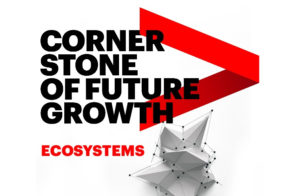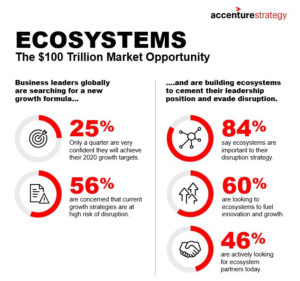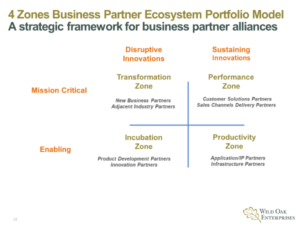
March 25, 2020
In the digital world,
building mutually successful business partner ecosystems is the new standard of competitive excellence

Historically companies believed they could create sustainable competitive advantage by owning and controlling the assets needed to build high barriers to entry into their markets. However, in the age of unprecedented waves of digital disruption, companies no longer have the capital, resources and capacity to own and operate all the assets they need to compete against well-constructed and well-orchestrated business partner ecosystems.
This continuously disrupted environment puts a premium on asset deployment rather than asset ownership to create sustainable competitive advantage and market leading financial results as shown below:
- Twenty years ago business partner alliances accounted for less than 3% of a company’s total revenue. Today that number has risen to over 40%.
- For every one dollar of Microsoft revenue, their partner ecosystem generates $9.00.
- Partner alliance revenues generate 19% higher margins than the next closest competitors.
Without having to spend their scarce capital to own assets, companies can access and deploy business partner assets at minimal marginal costs and market leading returns.
Business Partner Ecosystems represent a $100 trillion market opportunity
A major new research study conducted in 2018 by Accenture Strategy surveyed 1,252 C-level global executives to understand how their companies are creating competitive advantage by building business partner ecosystems.
The survey results documented that by aligning all business partner interests against mutually agreed upon outcomes exponentially increased their combined value proposition and distributed market risk equally across all partners. It also forecast that enabled by digital platforms, ecosystems could unlock $100 trillion in value for business and society over the next 10 years.

As the survey statistics on the chart above highlight, only 25% of senior business leaders feel confident that their companies will achieve their growth targets. 60% are actively looking to build ecosystems to drive innovation and growth.
Building a mutually successful business partner ecosystem is a step by step process

Successful business partner ecosystems don’t start fully constructed but rather they are put together over time with the continual addition of new partners and resources driven by market demand and competitive differentiation.
 Google Nest’s buildout of its business partner ecosystem provides a great example of this step by step approach. Google Nest’s initial product was a smart digital thermostat that could be controlled remotely to which it added a security alarm.
Google Nest’s buildout of its business partner ecosystem provides a great example of this step by step approach. Google Nest’s initial product was a smart digital thermostat that could be controlled remotely to which it added a security alarm.
To capitalize on the full potential of digital interconnections, it created the “Works with Nest” ecosystem which enabled partners to innovate and connect their products to Google Nest.
- LIFX designed and connected a red LED flash if the Nest smoke and safety alarms were activated which is “a literal lifesaver for the hard of hearing.”
- Fitbit’s wearable fitness tracker alerts Nest that the wearer is awake so it can warm up the house.
- Mercedes-Benz cars use GPS to tell Nest to switch on the heat before the person arrives home.
The growth and proliferation of digitally enabled partner ecosystems is also changing how market analysts are assessing sustainable competitive advantage. No longer is it a single company’s ability to dominate a market or sector, but rather it’s their ability to construct and orchestrate a partner ecosystem that spans industry boundaries and offers a bundled package of customizable products and services.
Using the 4 Zones Model as a strategic framework for business partner alliances
Constructing and orchestrating a well-designed, multi-faceted business partner ecosystem necessitates companies acquire the critical skills, tools, and resources necessary to make them successful. The 4 Zones Model provides a framework to help you identify and assemble a portfolio of partner alliances designed to deliver market leading customer experiences as shown on the slide below:

Successful business partner ecosystems share common principles and critical success factors including:
- A shared vision for a mutually beneficial business outcome
- Clear accountability and decision-making responsibility
- Total go-to-market alignment across the entire partner ecosystem
- Real time alliance performance metrics and reporting
- Willingness to share proprietary data and information
- Mutual trust to protect against cyber security threats
Besides expanding your product and service offers, business partner alliances are also a potential source to onboard new skills and capabilities that your company may lack.
By example, Apple & Cisco have teamed up with insurer Allianz SE to offer discounts on cyber insurance to businesses that primarily use equipment from both technology companies. The alliance also includes insurance broker Aon Plc, who provides customers with more favorable terms on cyber coverage such as lower deductibles, as well as support services in the event of an attack.
Like a business investment portfolio where risk and return are spread across multiple investment options, the 4 Zones business partner alliance portfolio is designed to create and deliver new value in four different categories.
The 4 Zones value creation portfolio approach provides a framework, vocabulary and decision-making process that enables senior leadership teams to discuss, segment and prioritize multiple business partner alliances. It also enables them to successfully deploy digital technologies as a primary source of value creation that generate market differentiating results.
As always, I am interested in your comments, feedback and perspectives on the ideas put forth in this blog. Please e-mail them to me at pdmoore@woellc.com. And, if this content could be useful to someone you know please share it here:


